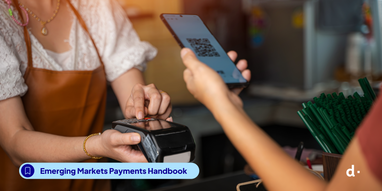Alternative payment methods: The everyday reality in Emerging Markets

What’s called alternative elsewhere is just normal here. Across emerging markets, payment habits are mobile-first, offline-to-online, and shaped by trust. APMs are the norm.
Quick summary
- Alternative payment methods (APMs) now power more than half of all online transactions across emerging markets.
- APMs reflect how people in these countries live, earn, and spend—mobile-first, infrastructure-light, trust-heavy
- From QR codes to real-time transfers, APMs help expand financial inclusion.
- This blog continues our series based on dLocal’s Emerging Markets Payments Handbook 2025
Reframing payments: it's not either/or, it’s about fit
In many parts of the world, payment strategies have traditionally started with banks and cards. But in emerging markets, local and alternative payment methods (APMs) have taken the lead, shaped by infrastructure that developed along mobile-first and cash-to-digital lines.
Users across Africa & the Middle East, Asia, and Latin America often enter the digital economy through mobile-first rails: eWallets, cash vouchers, and real-time transfers. These aren’t add-ons, they’re the first option that actually works for them. And while cards continue to play an essential role in key industries like travel, subscriptions, and higher-value retail, the center of gravity is shifting.
It’s not about one method replacing another, but about offering what makes sense for that user, at that moment.
Breaking down alternative payment methods
While in mature markets APMs may be considered “alternative,” in much of the Global South, they are the core infrastructure. APMs vary by region but typically include:
- Real-time payments (RTP): Fast, bank-initiated payments that settle instantly. From Pix in Brazil to UPI in India and SPEI in Mexico, RTPs are the backbone of person-to-person and merchant flows.
- Bank transfers: Including scheduled or batched transfers used for high-value purchases, recurring payments, and services like utilities, especially in markets like South Africa, Colombia, and Nigeria.
- eWallets: App-based wallets (e.g. GCash, OVO, Yape) used for transport, utilities, food delivery, and eCommerce, frequently funded by cash or RTPs and deeply embedded in mobile ecosystems.
- Mobile Money: Particularly relevant in Sub-Saharan Africa, mobile money (like M-PESA or MTN MoMo) allows users to hold and move funds through telecom networks.
- BNPL: Often offered by local fintechs or retailers, Buy Now, Pay Later fills credit gaps by allowing installment payments without a credit card. Demand is high in categories like electronics or travel.
- Cash-based digital payments: Still relevant across many markets, these include cash vouchers and over-the-counter payments like Boleto (Brazil), OXXO (Mexico), or Fawry (Egypt). They bridge the offline world with online checkouts.
What unites these methods is alignment with local infrastructure and behavior. APMs are used because they fit how people already transact.
Behavior leads, not just access
People in emerging markets often manage money across multiple informal and formal sources—gig work, remittances, and small business income are all common. They look for payment options that feel immediate, familiar, and intuitive. This creates a different set of expectations at checkout.
Timing, transparency, and recognition matter more than convenience alone. That’s why many users default to eWallets like Yape in Peru, GCash in the Philippines, or Easypaisa in Pakistan. These methods align with how people already think about money.
- In Colombia, a third of online payments go through bank transfers
- In Brazil, Pix now processes over 10 billion transactions each month, outpacing cards
- In the Philippines, eWallets, like the leader GCash, are used for over 70% of gaming and ride-hailing payments
- In India, UPI powers over 60% of eCommerce, even outside the largest cities
- In Egypt, almost 80% of online orders are paid via APMs like Fawry, cash on delivery or other digital payment options
What starts as a workaround often becomes the new standard—especially when it aligns with how people already manage money
When payments fit the use case: Industry patterns
We’re seeing clear links between payment method preference and the nature of the transaction. In many markets, APMs outperform other methods in specific industries, not just because they’re available, but because they align with how people engage with each service.
In streaming and gaming, for instance, eWallets and SuperApps lead thanks to fast, embedded checkouts and deep mobile integration, often powering over 70% of payments in these industries. In retail, offline-to-online flows like cash vouchers remain widely used, while credit cards still play a key role in larger purchases. BNPL is also gaining ground, giving users a way to split payments without relying on traditional credit.
Other sectors follow their own logic. In ride-hailing, cash is still common in some markets, but mobile payments are quickly gaining ground as users prioritize real-time confirmation and convenience, especially through eWallets, which are leading in this space.
In travel, affordability and trust shape choices—cards, BNPL, and bank transfers are commonly used to manage cost and timing. In SaaS and other subscription services, bank transfers and cards also remain the primary methods, especially for invoicing and recurring payments. But increasingly, tokenized APMs are enabling one-click and repeat transactions, offering a locally relevant alternative that aligns better with user expectations.

From fragmented rails to everyday ecosystems
APMs were once seen as fragmented—each market with its own rules, rails, and flows. But that’s changing. Regions are now investing in interoperability: UPI works cross-border in places like Singapore and the UAE; Southeast Asia is building a shared QR wallet network; and projects like PAPSS in Africa and Project Nexus aim to connect local systems into broader, global rails.
At the same time, APMs are evolving beyond payments. Many now function as full-service financial ecosystems: supporting savings, credit, and even insurance. Platforms like NuPay in Brazil, Capitec Pay in South Africa, and OVO in Indonesia offer features like stored credentials, recurring billing, and tokenized flows. In markets with low card penetration, this enables a subscription-like experience built entirely on local infrastructure.
Key takeaways
- APMs are dominant across many emerging markets, not peripheral, but foundational
- Cards, global and local, remain essential, especially in high-trust verticals like travel and subscription services like SaaS
- Payment success depends on behavioral fit, not just system compatibility
- APMs are evolving beyond transactions into full-service platforms
- Local context should guide product decisions at checkout—conversion starts with trust
What’s next in this series
Our upcoming blogs break down payments by region—exploring Asia’s instant payment foundations, Africa’s mobile money networks, the Middle East’s customer preferences, and LATAM’s hybrid ecosystems—offering strategies from dLocal’s Emerging Markets Payments Handbook 2025.
Get in touch with our payment experts
We help global companies such as Amazon, Spotify, and Microsoft find new opportunities in high-growth markets. Let's think outside the box for tailor-made payment solutions for your business. Fill out this form, and we'll get back to you as soon as possible.
Contact us




